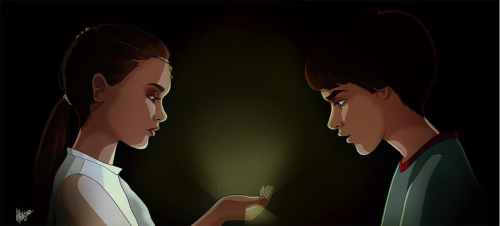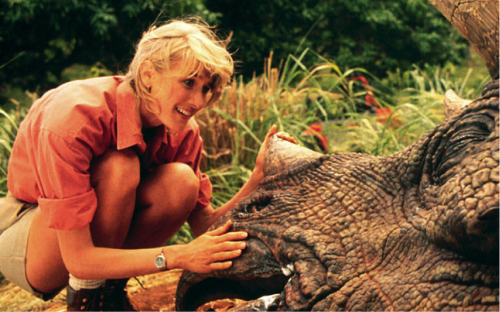This is a guest post by Ashley Barry.
When I was younger, I had an imagination that was overflowing with all manners of people and expansive lands. Entertained by my own thoughts and ideas, I would play by myself for hours and hours on end. I used to dread play dates because I much preferred the company of my rich imagination and the companions that resided within it. What was the point of interacting with an ordinary person my age when I could be taking a refreshing dip with mermaids or assisting a prince on his journey through a dense, dangerous jungle? My mother would frequently find me, an odd and pensive child, in the most peculiar places: sitting cross legged atop the kitchen counter, wedging myself behind the furnace, and, much to her dismay and frustration, climbing around in my dad’s tool closet.
I’m now an adult woman and, aside from getting a little taller and acquiring more responsibilities, not much has changed in terms of my colossal imagination and insatiable hunger for fiction. I’m a 27-year-old woman who still likes to play and pretend, a kind of mindset that we should never age out of but often do. Even when functioning within an adult sphere at my workplace, I occasionally glance out the skyscraper window and imagine there’s an enormous dragon peering in at me. I allowed my imagination, despite my age and what society may deem appropriate. Adults who continue to nourish their imaginations are, more often than not, negatively stigmatized because it’s juvenile and childish. Why? What’s wrong with stubbornly grasping onto that childlike part of ourselves? Having an imagination is one of the best things a person can possess. It should never be dismissed or considered useless. On the flip side of this issue, there are several mediums in which fictional adults attempt to rid children of their imaginations and imaginative thoughts. How come?
In Return to Oz, Dorothy Gale, the heroine of the film, is sent away by her aunt to receive shock therapy because she’s unable to sleep due to her memories of Oz. However, prior to her visit to the mental institution, there’s a moment where Dorothy presents a mysterious key to her aunt. She excitedly tells her aunt that the key bears the Oz symbol and yet her aunt dismisses her claim. Her aunt then goes on to remind Dorothy to not talk about Oz because it’s just her imagination. Rather than believing Dorothy’s claim, the scene further supports the idea that the imaginative child is a child that requires some kind of fixing. Though Dorothy’s relationship with her aunt improves at the end of the film narrative, she still keeps her “imaginative” self hidden from her. When Dorothy calls for her aunt to come and see Ozma, Oz’s daughter and heir, in the mirror, the blond girl just shakes her head and presses her finger to her lips. It’s a really telling a moment, a moment that opens a dialogue about the obvious division between adults and children.
I always envied fictional children like Dorothy Gale and Alice Liddell. How could I not? They possessed agency in their own fantastical realms, befriended magical creatures, and experienced once-in-a-lifetime adventures (sometimes misadventures). Were their friends and experiences any less real than mine? Rather than looking to fictional adults for assistance and guidance, these fictional children oft rely on their wits and inner strengths. Whether it was Atreyu’s miserable trek through the swamp of sadness or Alice outsmarting an evil Queen that’s overly fond of beheading others, fictional children are just as capable and complex as adults, but they don’t always receive the proper credit or consideration they deserve. When operating as agents outside of their whimsical kingdoms, adults commonly other them.
When it comes to the representation of children in pop culture at large, most mediums commonly illustrate the dichotomy of power between adults and children. One of the more prominent examples that I can think of is the infamous power struggle in Matilda (1996). There’s a constant battle for power between Miss Trunchbull, a shockingly abusive school principal, and Matilda, a puny girl that can move objects with the power of her mind. There’s a scene in which Miss Trunchbull, large and horrible with her mess of teeth, loudly informs Matilda that she’s big and right and overall better than our exceptionally smart heroine:
“Even if you didn’t do it, I’m going to punish you because I’m big and you’re small and I’m right and you’re wrong and there’s nothing you can do about it.”
Matilda’s an interesting example because she’s mature and capable, but she’s still able to sustain her imagination and lose herself in a good book. She pushes against the idea that imaginative children are aloof, lost, or incapable. There’s a lovely instance in which Matilda, who’s much younger at this point in the film, is giggling in an oversized chair in the library, amused by whatever it is she’s reading. Viciously mean and dismissive of children and their ideas, Miss Trunchbull is a villain through and through. I always adored Roald Dahl because I felt that he was always rooting for the children in his novels. He crafted such detestable adult villains, adults that couldn’t be trusted or relied upon. He also created wonderful child characters that never lost sight of their imagination and used it as a way to succeed or solve problems.
Tim Burton’s Alice in Wonderland (2010) is very positive in its presentation of imaginative children and adults. Like Dorothy, Alice frequently wakes up at night because of her fanciful experiences in Wonderland. However, at the beginning of the film, there’s a moving scene between Alice when she’s a little girl and her father. When she tells him that she thinks she might be mad due to her memories of Wonderland, her father informs her that all the best people usually are. He’s one of the few fictional adults that believes in Alice and is on her side. He’s not at all dismissive of her and her “imagined” experiences.
I adore adult Alice because she’s a positive representation of a creative person with an endless imagination. Though some adults are dismissive of her and think her a dreamer, I see her as an innovator and a person who is more than capable of changing the world. When her mother discovers that her daughter isn’t wearing a corset or stockings, I couldn’t help but laugh and like her even more. She doesn’t adhere to norms or traditions, a sure sign of a person who thinks outside the box. There’s a spectacular instance at the end of the film when she’s standing atop the deck of a ship that’s about to depart. As a blue butterfly lands on her shoulder, a friend from Wonderland, she welcomes him and doesn’t deny or overlook his existence. She grows to accept that Wonderland is not a dream, but a fragment of her true self. The film is really about reacquainting oneself with a lost and or forgotten identity.
The NeverEnding Story (1984) is another film that celebrates creativity and imagination. Bastian, the boy protagonist, differs from the other fictional children in that he nearly destroys Fantasia because of what his father says in one of the first scenes. When the childlike Empress pleads for his help, frantically asking him why he doesn’t “do as he dreams,” he tells her that he has to keep his feet on the ground, which was the exact phrase his father had said to him at the beginning of the movie narrative. It’s a frightening instance because his father almost hammered his whimsical ways out of him. When he saves Fantasia and accepts himself as the dreamer that he is, he’s able to cross into Fantasia or bring the creatures of Fantasia into his own world. The ending montage is great because it shows a much happier Bastian riding Falkor, the luck dragon, in both worlds.
The children of Oz, Fantasia, and Wonderland prevailed over the adults that attempted to fix or dissuade them. These fictional children are innovative, ambitious, and victorious. If anything, their innovativeness got them through various obstacles. I’ll always fight against the stigmatization of imaginative adults and children. I sure as hell know I’ll forever have one foot in an imagined realm because that’s where I belong and love to be.
Ashley Barry works at a publishing house in Boston and holds a master’s degree in children’s literature. Though her background is in the book business, she loves writing about all mediums. She’s also a contributing writer for a video game website called Not Your Mama’s Gamer. She can be reached at abarry4099@gmail.com.







